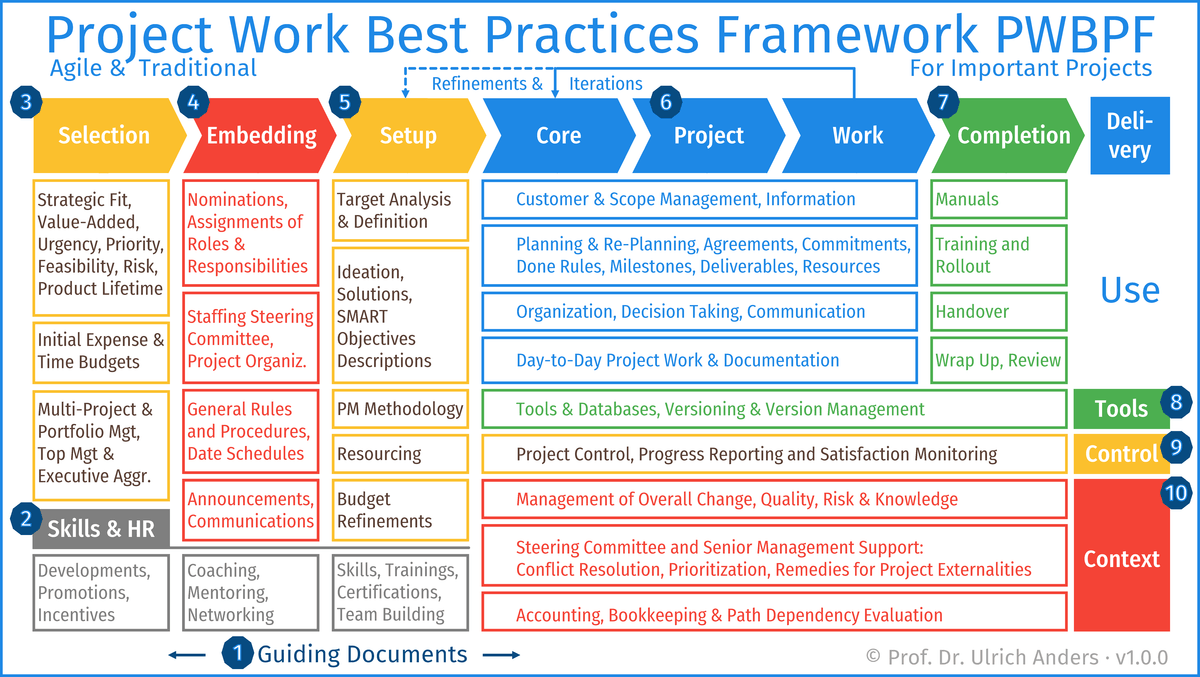Project Work Best Practices Framework
v1.0.0
·Prof. Dr. Ulrich Anders
"Project Management without status reports is like an aeroplane without instruments. You would basically fly blind."
v1.0.0
·Prof. Dr. Ulrich Anders
The management and control of projects require experience, skills and support. The more of this is provided in a systematic and prepared form by a company the more likely is efficient project work and project success. A score can help to establish the project management maturity of a company.
Not every small project requires a systematic approach to project management and control. But certainly for projects that are important (and expensive) for the company a systematic approach is sensible. In order to not waste resources by re-inventing the wheel with every project, it makes sense for every company to support project work.
When is a project important? Obviously, this depends on the company and its own definition. If you need a guideline as a starting point, you can use these criteria. The project:
It is kind of obvious that under such pre-requisites, a project deserves good support, infrastructure, expertise, and guidance.
Otherwise, projects are developed by the people involved in an ad-hoc fashion and on a best effort basis. In the absence of generally available definitions, procedures, tools and templates, everything will be developed again and again from scratch. As a result, the project landscape of a company looks scattered and very inhomogeneous. Every project uses different tools, every methodology is implemented with individual tastes or convictions, every status report looks different and nothing can be aggregated for executive and senior management in a comparable manner. As a further consequence, project people can not properly network because they all use a different basis and skill sets cannot be systematically trained on the same common ground and understanding.
On top of that — and without a systematic approach — companies run significant risks of losing valuable knowledge at project completion or of reacting much to slow to typical problems or issues that otherwise could have been overcome in a short time.
In order to address such deficiencies a company should employ best practices at every element of a project. This makes project work most efficient and generally generates highest quality output. It also allows companies to constantly improve and to use the experience from past projects as a foundation of future projects.
The elements of a project result from the typical project phases and the necessary supporting elements for efficient project work. All these elements together will make the Project Work Best Practices Framework (PWBPF). Now each element of the Best Practices Framework can be evaluated and summarized in a score — the Project Work Best Practices Score for project work.
The evaluation of each of the elements is performed by help of a (self-assessment) questionnaire. Best practices are defined by (a) what prevents ad-hoc processes, re-inventions, always starting from scratch, individual status template designs, by (b) what makes a project synergetic, efficient, skillful, knowledgeable, transparent, and more successful and by (c) what makes the company more experienced with respect to project work as a whole.
You can test how mature your company is with respect to Project Management and Control. The Project Work Best Practices Score will be within a range of 0−100%. The score will also give you an indication in which category you can improve.

In order to get a better understanding what each of the maturity levels mean have a look of what you can typically find as achievements on each level.
A more detailed description of the five maturity levels. The bullet points explain what companies typically have achieved on each level. A higher level encompasses all achievements of the lower levels.
There are a number of other models that also evaluate the project management maturity. If you are interested in further explorations have a look at:
Naturally, there is some overlap between all these models. The advantage of the Project Work Best Practices Framework is that it is systematically evaluating all elements of project work and that it offers an interactive and comprehensible score.
© Prof. Dr. Ulrich Anders
prof.anders@online.de
https://project-status.orgLicense: CC BY-ND 4.0Factory ResetVersion: 0.17.6.alpha | API 6
Last change: 2022-01-02|00:58
Browser: undefined
